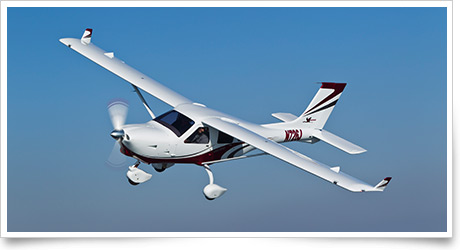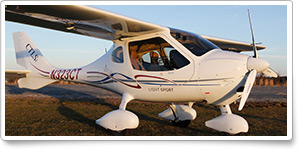|
|||||
Training TipsThe why of winglets
“Notice anything unusual about that airplane?” asks your instructor.
Given the question, you know the answer has to be “yes,” so you give the aircraft an extra careful inspection as it rolls past.
“Winglets,” the CFI says, pointing to small vertical airfoils at the tips of the airplane’s wings.
Why winglets?
Frequently a design element of large jet and turboprop aircraft, winglets—designed to address aerodynamic inefficiencies of the airflow around wingtips—have begun to appear as original equipment or as aftermarket installations on smaller aircraft. The basic idea is that winglets can counteract a loss of lift resulting from the phenomenon of wingtip vortices.
“The high-pressure area on the bottom of an airfoil pushes around the tip to the low-pressure area on the top,” explains the Pilot’s Handbook of Aeronautical Knowledge. “This action creates a rotating flow called a tip vortex. The vortex flows behind the airfoil creating a downwash that extends back to the trailing edge of the airfoil. This downwash results in an overall reduction in lift for the affected portion of the airfoil. Manufacturers have developed different methods to counteract this action. Winglets can be added to the tip of an airfoil to reduce this flow. The winglets act as a dam preventing the vortex from forming. Winglets can be on the top or bottom of the airfoil.”
Designs have advantages and drawbacks, so designers are further subdividing winglets as either passive or active devices.
“Passive winglets such as those found on airliners and business jets today impart a bending moment to the wing, due to the extra lift they provide at the very tip,” explained this October 2012 AOPA Online article. “Either the wing connection to the fuselage must be strengthened, or the winglets must be small enough to avoid extra strain.” By contrast, active winglets tested by AOPA are designed to “turn off” the extra lift when wing loads are high.
More benefits were suggested when recent testing of winglets on a Piper Aerostar twin-engine aircraft demonstrated better handling during stalls, and increased safety margins in slow-speed flight.
Winglets are even finding their way into future propeller design for the light sport and experimental aircraft market, striving for the dual benefits of increased efficiency and reduced noise. Flight Training NewsAirplanes, potato chips: It just takes a taste, school saysTake a couple of shiny, new aerobatic aircraft and match them with enthusiastic, expert instructors, and you might just have a winning combination when it comes to spreading the passion for aviation and recruiting new pilots. California’s 5g Aviation is banking on that, and so far, it seems to be succeeding. “If you get in that airplane and go up with one of my instructors, you’re going to fly again,” said 5g Aviation CEO Ty Frisby. “It’s like you can’t just eat one potato chip.” Read more >> FAA agrees to drop dated material from knowledge testsThe FAA has agreed to remove questions that focus on obsolete terms and technologies from airman knowledge tests in response to a request from the co-chairs of an industry/government group that is drafting revisions to training and testing standards. AOPA welcomed the FAA’s response as a “very positive step” to advance the goals of the Aviation Rulemaking Advisory Committee’s Airman Testing Standards and Training Working Group. Read more >> NASA holds aerospace education program for teensAfter spending six months learning and communicating via the Web, 170 rising high school seniors from across Virginia are working on an intensive aerospace education program by planning a mission to Mars during weeklong summer academies at NASA Langley Research Center. Students are part of the Virginia Aerospace Science and Technology Scholars (VASTS) program, an interactive, online science, technology, engineering, and mathematics (STEM) learning experience that offers student participants workforce experience as well as college credit. Independence Aviation, STEM Ventures team for summer youth labTwenty sixth- through ninth-grade students from Colorado's South Metro Denver area will get up-close-and-personal with the world of flight in July at Centennial Airport through a weeklong learning lab held jointly by Independence Aviation LLC, a flight school/flight services company based at the airport, and STEM Ventures LLC, which provides science, technology, engineering, and mathematics (STEM) education for K through 12 students. Highlights of the week include a tour of an aviation maintenance facility, a tour of the Metropolitan State University of Denver Aerospace Department, and taking the controls of simulated flights in Independence Aviation’s Frasca Cirrus SR22 Level 1 flight training device. Do you know where you are? Are you sure?Knowing where you are on the airport seems like a simple task, but its importance cannot be overstated. Confusing airport layouts, poorly lit (or completely unlit) runways or taxiways, and in-cockpit distractions are all factors pilots must be aware of, or disregard at their own peril. In this animated video from the Air Safety Institute, watch as a lack of situational awareness ends with a fatal outcome. Watch the video >> You and your aircraftAs you learn to fly, your skills are improving, and you are becoming a better pilot. But is your airplane improving along with you? After all, each one of those bounced landings and abrupt power changes takes its toll on the aircraft's service life. Learn more about the wear and tear an aircraft endures, the telltale signs of aircraft fatigue, and much more by taking the Air Safety Institute's Aging Aircraft online course. Log in to take the course >>Training ResourcesSay intentions … when you need ATC’s helpMost flight assists involve general aviation pilots. Do you know how to ask for air traffic control’s assistance during emergency or urgency situations? This Air Safety Institute publication will explain how ATC can help you, as well as what controllers cannot do to help. Read more >>
Did you know that student pilots who join AOPA are three times more likely to complete their flight training? Membership includes unlimited access to aviation information by phone (800/USA-AOPA, weekdays from 8:30 a.m. to 8 p.m. Eastern time) or from Flight Training Online or AOPA Online. If you’re not already a member, join today and get the pilot’s edge. Login information is available online.
Customs responds on aircraft searchesAOPA got an answer from Customs and Border Protection regarding searches of general aviation aircraft—and it's not the one you want. The accident involving an Asiana Airlines Boeing 777 in San Francisco puts a spotlight on potential safety issues in the landing phase of flight; AOPA Live discusses the importance of a stabilized descent. And fly into Big Bear, Calif., with brothers George and John Kounis of Pilot Getaways magazine. AOPA Live This Week, July 11. Career PilotCourt upholds Delta, ALPA challenge to loan guaranteesThe Washington, D.C., Circuit Court of Appeals on June 18 upheld a challenge by Delta Air Lines and the Air Line Pilots Association to Export-Import Bank loan guarantees for 30 long-range, widebody aircraft sold to Air India. “Delta and ALPA had argued that the subsidies would have harmful effects on U.S. airlines and their employees,” Delta said. “The federal appeals court held that, before issuing its loan guarantees to Air India, the bank was required by its governing statute to consider the effects that the loan guarantees would have on U.S. industries and U.S. jobs.” The bank failed to explain its exclusion of aircraft transactions from economic impact review, according to the court. Regional airline pilot conferenceFAPA.aero is holding a Regional Pilot Career Conference and Job Fair at the Denver Airport Marriott at Gateway Park on Saturday, July 13. Confirmed airlines to be in attendance include AirNet Express, American Eagle, ExpressJet, Republic, and Mesa Air. FAPA.aero will also hold a Global Pilot Career Conference and Job Fair on Oct. 25 and 26 in Chicago. United Airlines has confirmed its attendance, and several other regional and international carriers are also expected to attend.
For more aviation career news, see the Flight Training website. Plane SpotterAn injection of technology: CTLSi
Training ProductsNew e-book on becoming a pilot releasediFLYblog.com has released a new free e-book, How To Be A Pilot, that walks those interested through the process of getting their pilot certificate, step-by-step. Written by an experienced flight instructor, this book is full of insider tips and techniques to set candidates up for success. Microsoft releases second edition of flight sim bookAuthor Bruce Williams has released the second edition of Microsoft Flight Simulator as a Training Aid, a guide for anyone who wants to maximize his or her real or virtual cockpit experience while learning more efficiently with less stress, and having more money left in the bank at checkride time. The book and accompanying CD provide general suggestions, specific advice, and practical tools for making effective use of Microsoft Flight Simulator as an aid to becoming a pilot. The cost is $29.95.
Note: Products listed have not been evaluated by ePilot editors unless otherwise noted. AOPA assumes no responsibility for products or services listed or for claims or actions by manufacturers or vendors. Member BenefitsDocuments pilots need to provide for conditions AMEs can issueDr. Warren S. Silberman offers pointers on what you need to get your treating physician to provide to you prior to visiting your aviation medical examiner if you have glaucoma, chronic hepatitis C, hypothyroidism, or hypertension. Read more >> Five good reasons to say yes to a business aircraftSmall businesses and entrepreneurs can use general aviation aircraft to gain a competitive advantage. AOPA Aviation Finance Co. tells members how. Read more >> BlogsYour instrument training tipsSince many pilots start instrument training almost immediately after completing their private pilot certificate, AOPA Technical Editor Jill Tallman wondered if Flight Training’s Facebook friends had any tips for those about to take the plunge. Turns out, they did—probably based on personal experience. As with almost any aviation topic, there were some divergent views. Read more >> Uncommanded yawIn cruise flight, should a helicopter experience an uncommanded yaw the cause in most cases would be an engine failure or tail rotor failure. The direction of the yaw indicates the type of failure. Read more >> AOPA Career OpportunitiesEver dream of turning your passion for aviation into a career? We’re looking for an aircraft analyst, director of corporate partnerships, marketing specialist, software test and quality assurance analyst, and AOPA Live editor/graphic artist. To learn more about other AOPA career opportunities, visit AOPA Online. Community
AVIATION EVENTS & WEATHER
|
||||||||||||||||||||||||||||||||||

 A light sport aircraft taxies by as you are tying down your trainer after the day’s flight lesson.
A light sport aircraft taxies by as you are tying down your trainer after the day’s flight lesson.



